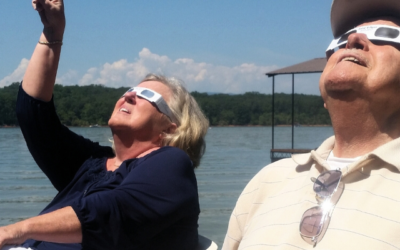 The annular solar eclipse of October 14, 2023, is rapidly approaching, and it’s not just a celestial event; it’s a cosmic spectacle that offers a unique opportunity to explore the beauty of Texas state parks while delving into the fascinating world of annular eclipses. In this extended post, we’ll take a deep dive into the captivating facts and science behind annular eclipses and introduce you to some of the state parks where you can witness this extraordinary phenomenon.
The annular solar eclipse of October 14, 2023, is rapidly approaching, and it’s not just a celestial event; it’s a cosmic spectacle that offers a unique opportunity to explore the beauty of Texas state parks while delving into the fascinating world of annular eclipses. In this extended post, we’ll take a deep dive into the captivating facts and science behind annular eclipses and introduce you to some of the state parks where you can witness this extraordinary phenomenon.
An annular eclipse, often referred to as the “ring of fire” eclipse, is a breathtaking celestial phenomenon that occurs when the moon partially covers the sun, leaving a brilliant ring of sunlight around its edges. While total solar eclipses captivate us by completely obscuring the sun, annular eclipses offer a different kind of visual marvel.
The Dance of Cosmic Proportions
The moon and the sun appear to be almost the same size in our sky, creating a cosmic coincidence that allows for these stunning annular eclipses. However, in reality, the sun is approximately 400 times larger than the moon, while the moon is about 400 times closer to Earth than the sun. This delicate balance in celestial sizes is what makes annular eclipses possible.
What sets the stage for an annular eclipse is the moon’s elliptical orbit around Earth. Unlike a circular orbit, the moon’s path is slightly elongated, resulting in variations in its distance from our planet. When the moon reaches its farthest point from Earth during its orbit, it appears smaller in the sky, creating the ideal conditions for an annular eclipse.
Annularity Duration: A Cosmic Coin Toss
The duration of the “ring of fire” phase during an annular eclipse can vary significantly. Several factors influence the duration, including the moon’s distance from Earth and the observer’s location. In some cases, lucky spectators may enjoy up to five minutes of annularity, while others might witness a shorter period. Regardless of the duration, the sight of the radiant ring encircling the moon is a celestial spectacle that leaves a lasting impression.
A Rare Cosmic Occurrence
Annular eclipses are relatively rare events, occurring approximately once every 18 months somewhere on Earth’s surface. This rarity adds to their allure, making each annular eclipse a special moment in the world of astronomy and for those fortunate enough to witness it.
Scientific Insights into the Sun’s Corona
Annular eclipses offer more than just visual splendor; they provide scientists with a unique opportunity to study the sun’s outer atmosphere, known as the corona. During a total eclipse, the corona is typically visible but often too dim to study in detail. In contrast, during an annular eclipse, the moon’s position is such that it perfectly aligns with the sun’s center, offering a glimpse of the corona’s outer regions. This exceptional situation allows scientists to gather valuable data and insights into the dynamics of the sun’s atmosphere.
Fun Facts about Annular Solar Eclipses
Now, let’s delve even deeper into some fascinating facts about annular solar eclipses:
- Historical Significance: Throughout history, solar eclipses, including annular ones, have held significant cultural and scientific importance. They have inspired art, influenced calendars, and provided opportunities for astronomers to study the sun and its corona. Ancient civilizations often interpreted eclipses as omens or celestial messages.
- Eclipse Chasers: Just as there are avid aurora chasers and meteor shower enthusiasts, there is a dedicated community of eclipse chasers who travel the globe to witness these rare events. Some eclipse chasers have seen dozens of eclipses in different parts of the world, making them true experts in eclipse viewing.
- Protect Your Eyes: A critical aspect of viewing any eclipse is safety. Always use certified solar viewing glasses or safe viewing devices when observing an annular eclipse. Looking directly at the sun without proper protection can lead to serious eye damage. Safety should always be a top priority when enjoying celestial events.
- Art and Literature: Annular eclipses have inspired artists, writers, and poets throughout history. The otherworldly sight of the “ring of fire” has often been depicted in various forms of art and literature, emphasizing the profound impact these cosmic events have on human imagination.
- Solar and Lunar Eclipses: While annular eclipses occur when the moon is at its farthest point from Earth, total solar eclipses take place when the moon is at its closest point, allowing it to fully cover the sun. This contrast highlights the dynamic interplay between the moon, Earth, and the sun during different phases of its orbit.
Viewing the Annular Eclipse at Texas State Parks
 Now that you have a deeper understanding of annular eclipses, let’s turn our attention to the magnificent Texas state parks where you can witness this incredible event. These parks offer not only excellent eclipse viewing opportunities but also unique natural beauty and outdoor experiences.
Now that you have a deeper understanding of annular eclipses, let’s turn our attention to the magnificent Texas state parks where you can witness this incredible event. These parks offer not only excellent eclipse viewing opportunities but also unique natural beauty and outdoor experiences.
- Big Spring State Park: Located in West Texas, Big Spring State Park is a hidden gem boasting rugged landscapes and a serene ambiance. It provides an ideal setting to escape the city lights and immerse yourself in the eclipse’s beauty.
- Choke Canyon State Park: Nestled near Three Rivers, this park offers picturesque views of Choke Canyon Reservoir, providing a stunning backdrop for the eclipse. The serene waters mirror the celestial event above.
- Devils River – Del Norte Unit State Natural Area: For those seeking solitude and unspoiled wilderness, Devils River is a remote destination offering an unforgettable eclipse experience. The pristine river and dark skies create an awe-inspiring atmosphere.
- Garner State Park: Known for its crystal-clear Frio River and breathtaking vistas, Garner State Park is a beloved Texas destination that will add a touch of celestial magic to its natural charm. The park’s sprawling landscapes offer numerous vantage points to witness the eclipse.
- Goliad State Park: Steeped in history, Goliad State Park offers a unique blend of culture and nature. This makes it an excellent place to witness the eclipse while connecting with the past. Explore historical sites during the day and the cosmic spectacle at night.
- Goose Island State Park: Located on the Gulf Coast, Goose Island State Park offers a coastal eclipse experience with views of the “ring of fire” reflected in the waters of St. Charles Bay. The combination of nature and astronomy creates a unique ambiance.
- Government Canyon State Natural Area: Just outside San Antonio, this park provides a convenient option for city-dwellers looking to escape urban lights and enjoy the eclipse’s serenity. Explore the park’s trails and then turn your gaze skyward.
- Guadalupe River State Park: With the Guadalupe River winding through the park, you’ll enjoy the soothing sounds of flowing water as you witness the eclipse. The river’s tranquil ambiance adds to the overall experience.
- Hill Country State Natural Area: Situated in the heart of Texas Hill Country, this park offers rugged terrain and dark skies, creating an ideal backdrop for the eclipse. The rolling hills and open spaces provide ample room for eclipse enthusiasts.
- Kickapoo Cavern State Park: Explore vast cave systems during the day and then look up to witness the cosmic show above in this unique park. The underground wonders of the park complement the celestial spectacle.
- Lake Corpus Christi State Park: Located along the Texas-Mexico border, this park offers tranquil lakeside views. The calm waters create a unique ambiance for your eclipse experience, with the “ring of fire” mirrored on the lake’s surface.
These state parks not only provide exceptional eclipse viewing opportunities but also the chance to connect with nature and create lasting memories. The beauty of witnessing an eclipse in a natural setting is that you can soak in the sights and sounds of the environment while marveling at the cosmic spectacle above.
As you prepare for the annular solar eclipse, consider immersing yourself in the rich history and science behind these celestial events. Encourage your family, especially your kids, to explore the wonders of the universe and develop a lifelong fascination with the cosmos.




0 Comments